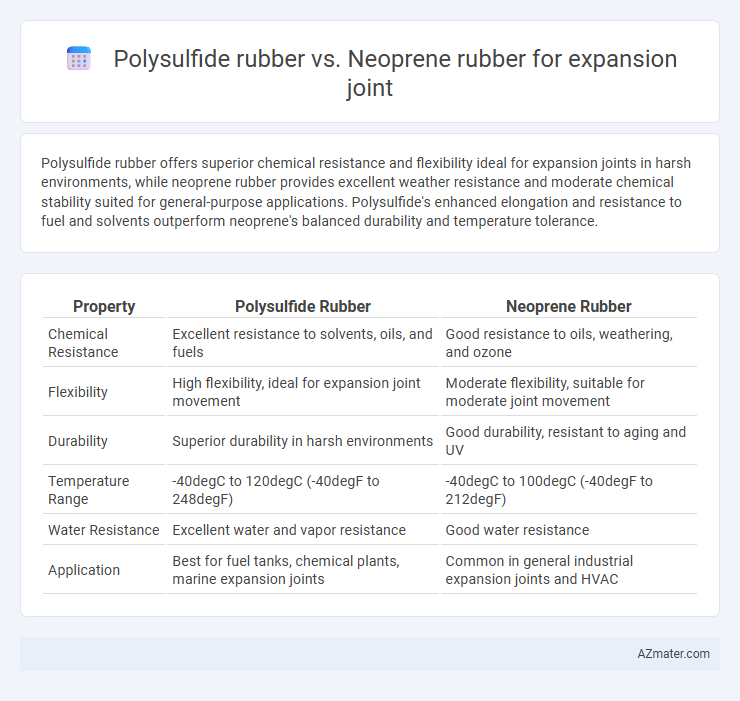Polysulfide rubber offers superior chemical resistance and flexibility ideal for expansion joints in harsh environments, while neoprene rubber provides excellent weather resistance and moderate chemical stability suited for general-purpose applications. Polysulfide's enhanced elongation and resistance to fuel and solvents outperform neoprene's balanced durability and temperature tolerance.
Table of Comparison
| Property | Polysulfide Rubber | Neoprene Rubber |
|---|---|---|
| Chemical Resistance | Excellent resistance to solvents, oils, and fuels | Good resistance to oils, weathering, and ozone |
| Flexibility | High flexibility, ideal for expansion joint movement | Moderate flexibility, suitable for moderate joint movement |
| Durability | Superior durability in harsh environments | Good durability, resistant to aging and UV |
| Temperature Range | -40degC to 120degC (-40degF to 248degF) | -40degC to 100degC (-40degF to 212degF) |
| Water Resistance | Excellent water and vapor resistance | Good water resistance |
| Application | Best for fuel tanks, chemical plants, marine expansion joints | Common in general industrial expansion joints and HVAC |
Introduction to Expansion Joint Materials
Expansion joint materials such as polysulfide rubber and neoprene rubber are critical for accommodating structural movement and preventing leaks in construction and industrial applications. Polysulfide rubber offers superior chemical resistance and flexibility, making it ideal for harsh environments with exposure to fuels and solvents. Neoprene rubber provides excellent resistance to weathering, ozone, and moderate chemicals, often preferred in exterior applications requiring durability and elasticity.
Overview of Polysulfide Rubber
Polysulfide rubber is a high-performance polymer known for its excellent chemical resistance, flexibility, and durability, making it ideal for expansion joint seals in harsh environments. Its unique molecular structure provides superior resistance to solvents, oils, and weathering compared to neoprene rubber, ensuring long-term performance under dynamic expansion and contraction. Polysulfide rubber also maintains elasticity over wide temperature ranges, enhancing its effectiveness in both industrial and marine expansion joint applications.
Overview of Neoprene Rubber
Neoprene rubber, a synthetic elastomer known for its excellent chemical stability and flexibility, is widely used in expansion joints due to its superior resistance to oils, chemicals, and weathering. Its ability to maintain flexibility across a broad temperature range (-40degC to 120degC) makes it ideal for dynamic joint applications exposed to harsh environmental conditions. Compared to polysulfide rubber, neoprene offers enhanced durability and moderate resistance to ozone and UV exposure, ensuring long-term performance in industrial and construction settings.
Chemical Resistance Comparison
Polysulfide rubber exhibits superior chemical resistance to fuels, oils, and solvents, making it highly effective for expansion joints exposed to harsh chemicals in industrial environments. Neoprene rubber offers moderate chemical resistance, especially against ozone, weathering, and some acids, but it degrades faster than polysulfide when in contact with hydrocarbons and certain solvents. In applications involving aggressive chemicals, polysulfide expansion joints provide longer service life and enhanced durability compared to neoprene alternatives.
Durability and Lifespan
Polysulfide rubber offers superior chemical resistance and excellent flexibility, resulting in enhanced durability for expansion joints exposed to harsh environmental conditions. Neoprene rubber provides moderate resistance to oils and weathering but generally has a shorter lifespan compared to polysulfide due to its lower tensile strength and aging properties. Selecting polysulfide rubber increases the operational lifespan of expansion joints, especially in marine and industrial applications where longevity and resilience against dynamic stress are critical.
Flexibility and Movement Accommodation
Polysulfide rubber offers superior flexibility and excellent movement accommodation in expansion joints due to its high elongation and resilience against deformation. Neoprene rubber provides good flexibility but generally withstands less dynamic movement compared to polysulfide, making it more suitable for applications with moderate expansion and contraction. Polysulfide's chemical resistance and low permeability enhance its capability to handle continuous joint movement without cracking or losing integrity.
Weather and UV Resistance
Polysulfide rubber exhibits superior resistance to UV radiation and harsh weather conditions, making it ideal for expansion joints exposed to prolonged sunlight and extreme climates. Neoprene rubber offers moderate weather resistance but tends to degrade faster under continuous UV exposure, leading to potential brittleness and cracking over time. Choosing polysulfide enhances the durability and longevity of expansion joints in outdoor applications subject to intense environmental stress.
Cost and Availability
Polysulfide rubber offers superior chemical resistance and flexibility for expansion joints but generally comes at a higher cost compared to neoprene rubber, which is more budget-friendly and widely available. Neoprene's extensive production scale ensures consistent supply and easier sourcing, making it preferable for projects with tight budget constraints and standard performance requirements. While polysulfide excels in specific corrosive environments, its limited availability and premium price can restrict use in large-scale or cost-sensitive applications.
Typical Applications and Suitability
Polysulfide rubber excels in expansion joints for chemical plants and wastewater treatment facilities due to its superior resistance to oils, solvents, and weathering. Neoprene rubber offers excellent suitability in construction and automotive applications, providing strong resistance to ozone, sunlight, and moderate chemicals. Both materials ensure flexibility and durability, but Polysulfide is preferred for harsh chemical exposure, while Neoprene is ideal for general-purpose sealing and outdoor environments.
Conclusion: Which Rubber is Better for Expansion Joints?
Polysulfide rubber offers superior chemical and UV resistance, making it ideal for expansion joints exposed to harsh environmental conditions and aggressive chemicals. Neoprene rubber provides excellent versatility and good resistance to weathering, ozone, and moderate chemical exposure, suitable for general-purpose applications. For expansion joints requiring enhanced durability and resistance to solvent-based chemicals, polysulfide rubber is the better choice, while neoprene suits budgets and less demanding environments.

Infographic: Polysulfide rubber vs Neoprene rubber for Expansion joint
 azmater.com
azmater.com